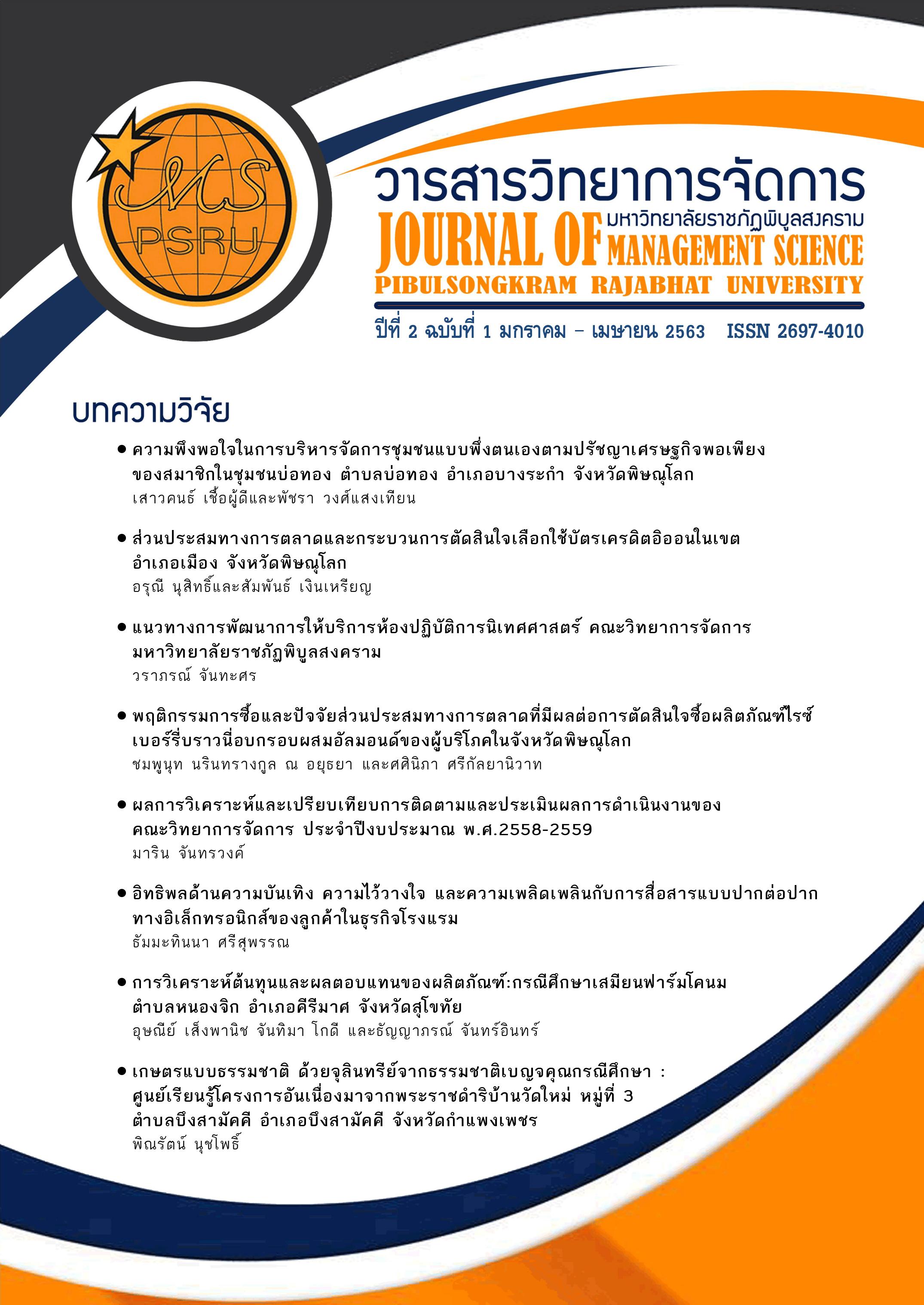เกษตรแบบธรรมชาติ ด้วยจุลินทรีย์จากธรรมชาติเบญจคุณ กรณีศึกษา: ศูนย์เรียนรู้โครงการอันเนื่องมาจากพระราชดำริบ้านวัดใหม่ หมู่ที่ 3 ตำบลบึงสามัคคี อำเภอบึงสามัคคี จังหวัดกำแพงเพชร
คำสำคัญ:
เกษตรแบบธรรมชาติ, จุลินทรีย์จากธรรมชาติเบญจคุณ, ศูนย์เรียนรู้, โครงการอันเนื่องมาจากพระราชดำริบทคัดย่อ
การศึกษาวิจัยในครั้งนี้มีวัตถุประสงค์ 1. เพื่อศึกษากระบวนการผลิตจุลินทรีย์ธรรมชาติเบญจคุณ 2. เพื่อศึกษากระบวนการใช้จุลินทรีย์ธรรมชาติเบญจคุณ 3. เพื่อศึกษาต้นทุนและประโยชน์ที่ได้จากการใช้จุลินทรีย์จากธรรมชาติเบญจคุณ การดำเนินงานวิจัยครั้งนี้เป็นการวิจัยเชิงคุณภาพ โดยการรวบรวมข้อมูลจากแหล่งทุติยภูมิ โดยการศึกษาเอกสารต่างๆ ได้แก่ เอกสารการวิจัย บทความ วารสาร หนังสือ แหล่งปฐมภูมิ และศูนย์เรียนรู้โครงการอันเนื่องมาจากพระราชดำริ บ้านวัดใหม่ หมู่ที่ 3 ตำบลบึงสามัคคี อำเภอบึงสามัคคี จังหวัดกำแพงเพชร โดยมีลุงเฉลิม พีรี เป็นผู้แนะนำให้ความรู้ตามวัตถุประสงค์ ผลการวิจัยพบว่า การทำเกษตรแบบธรรมชาติด้วยจุลินทรีย์ธรรมชาติเบญจคุณมีกระบวนการผลิตที่หาวัตถุดิบที่หาจากธรรมชาติ ซึ่งกล่าวได้ว่าเป็นการนำเอาจุลินทรีย์จากธรรมชาติมาแปรรูปให้ได้คุณประโยชน์สูงสุดแล้วส่งคืนให้กับธรรมชาติ โดยไม่ต้องใช้สารเคมีเป็นตัวช่วย เริ่มจากการทำความรู้จักกับธรรมชาติ ความต้องการของพืช พืชต้องการสารอาหารอย่างไร พืชสามารถตั้งท้องได้ เมื่อรู้จักแล้วก็สามารถนำก้อนเบญจคุณไปประยุกต์ใช้ได้ตรงเป้าหมาย จะสามารถนำไปใช้ได้ทั้งโดยตรงกับพืชตอนเตรียมดินโดยให้มูลสัตว์เป็นอาหารของจุลินทรีย์ในก้อนเบญจคุณ หรือจะเป็นการนำก้อนเบญจคุณไปทำเป็นน้ำหมักชีวภาพ ใช้ย่อยสลายฟางข้าวหรือฉีดพ้นทางใบ จากการสัมภาษณ์ลุงเฉลิม พีรี คนในอำเภอบึงสามัคคีก็เริ่มเปลี่ยนมาทำนาปลอดสารพิษ แบบประนีประนอมกับคนในครอบครัว โดยโซนการทำนาปลอดสารพิษแบบผสมผสาน ด้วยจุลินทรีย์ธรรมชาติเบญจคุณ เมื่อเห็นความแตกต่างจึงเปลี่ยนมาใช้จุลินทรีย์แบบเต็มตัว ซึ่งทำให้เห็นความแตกต่างด้านค่าใช้จ่าย ด้านต้นทุนที่แตกต่าง เมื่อเทียบกันจึงเห็นความแตกต่างอย่างมาก สามารถลดต้นทุนได้ ประหยัดเงินที่ไม่น่าจะเสียออกไป พร้อมกับได้ผลผลิตที่ดีขึ้นทุกปี
References
ณัฐภูมิ สุดแก้ว. (2558). การทำจุลินทรีย์เบญจคุณและการนำไปใช้ทางการเกษตร. เกษตรกรรมธรรมชาติ, 17(4), 25-53.
ทิพวรรณ สิทธิรังสรรค์. (2551). แนวคิดเกี่ยวกับเกษตรธรรมชาติของโมกิจิโอกาดะ. (พิมพ์ครั้งที่ 1). กรุงเทพฯ: โอเดียนสโตร์.
อานัฐ ตันโช. (2548ก). ทฤษฎีเกษตรธรรมชาติ. (พิมพ์ครั้งที่ 4). เชียงใหม่: Trio Advertising & media Co.,Ltd.
อานัฐ ตันโช. (2458ข). จุลินทรีย์ท้องถิ่น (Indigerous Microorganism: IMOs). (พิมพ์ครั้งที่ 4). เชียงใหม่: Trio Advertising & media Co.,Ltd.
Downloads
เผยแพร่แล้ว
How to Cite
ฉบับ
บท
License
บทความที่ได้รับการตีพิมพ์ในวารสารวิทยาการจัดการมหาวิทยาลัยราชภัฏพิบูลสงคราม เป็นลิขสิทธิ์ของ คณะวิทยาการจัดการ มหาวิทยาลัยราชภัฎพิบูลสงคราม บทความที่ลงพิมพ์ใน วารสารวิทยาการจัดการมหาวิทยาลัยราชภัฎพิบูลสงคราม ถือว่าเป็นความเห็นส่วนตัวของผู้เขียน คณะบรรณาธิการไม่จำเป็นต้องเห็นด้วย ผู้เขียนต้องรับผิดชอบต่อบทความของตนเอง


